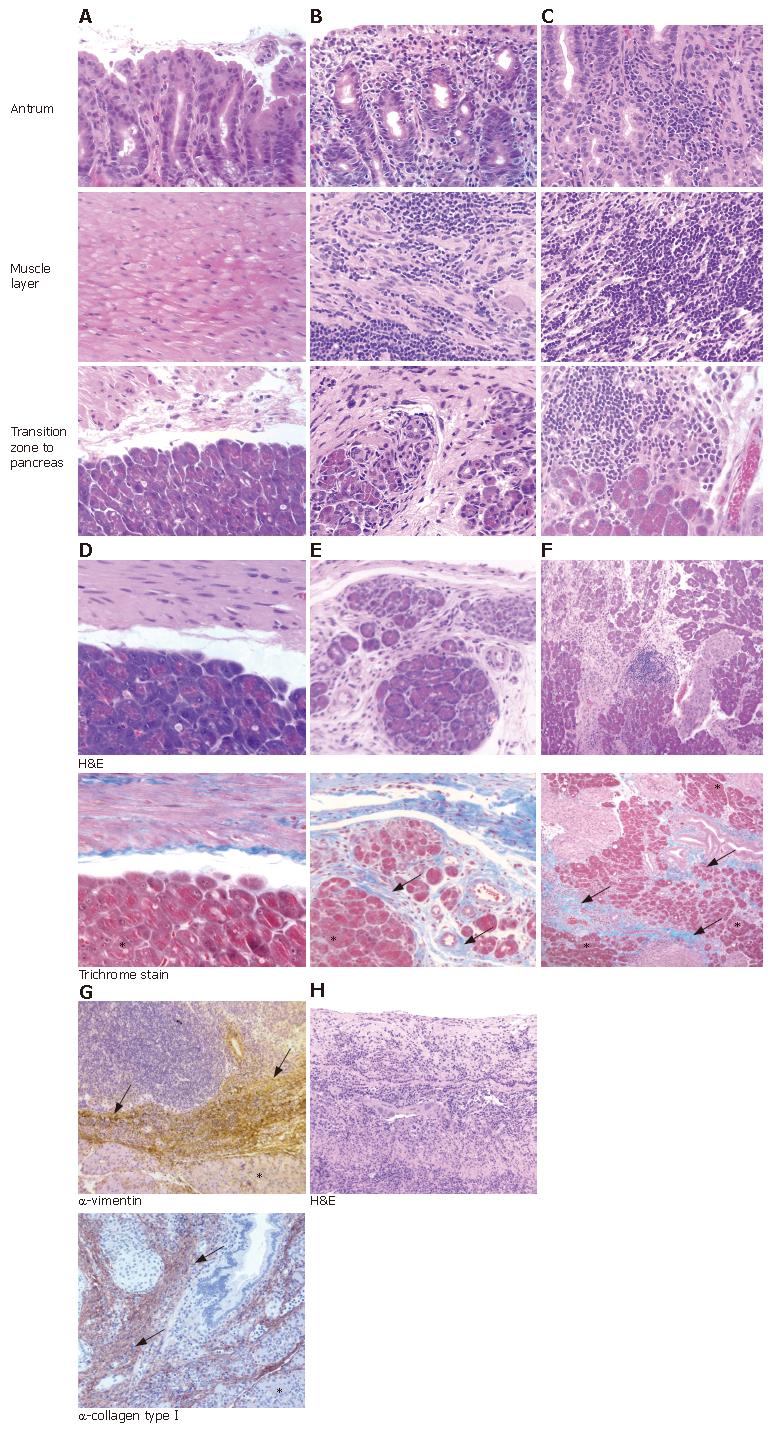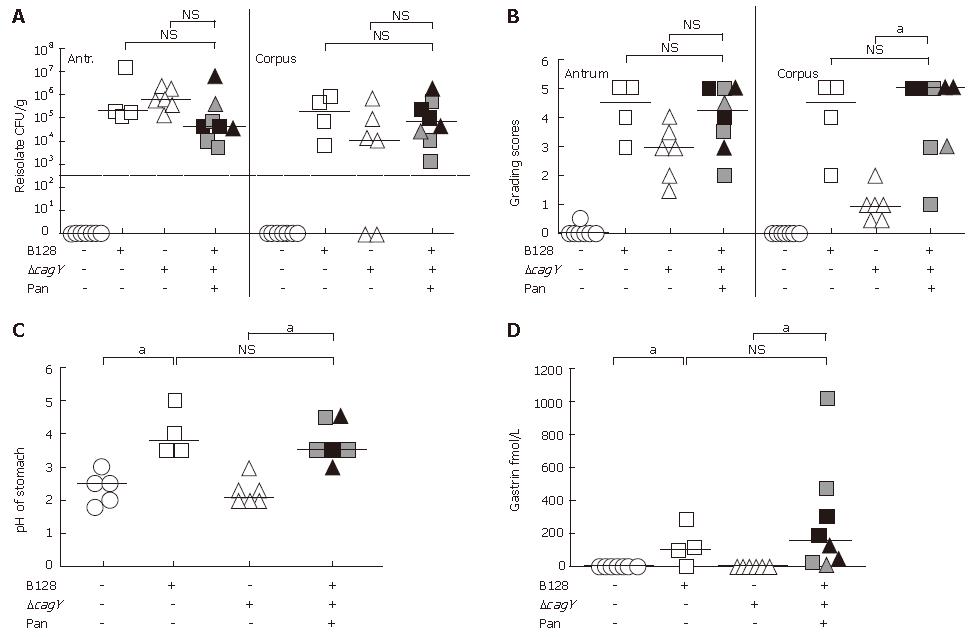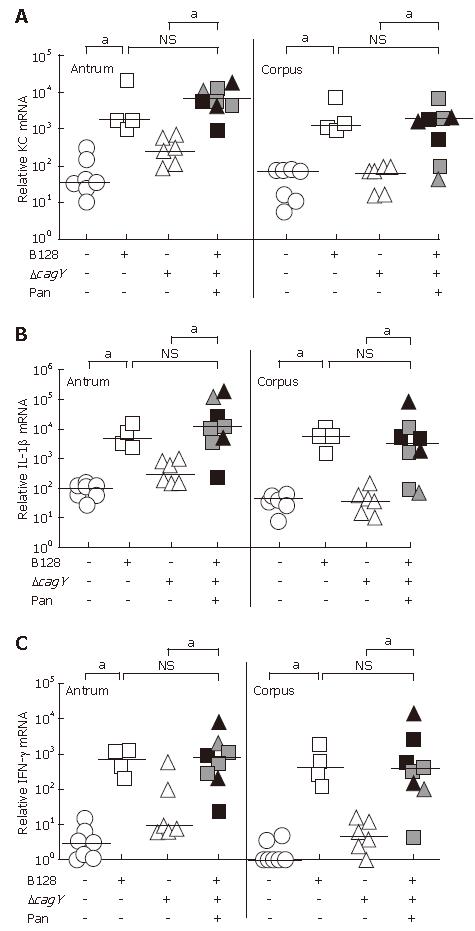Copyright
©2007 Baishideng Publishing Group Co.
World J Gastroenterol. Aug 7, 2007; 13(29): 3939-3947
Published online Aug 7, 2007. doi: 10.3748/wjg.v13.i29.3939
Published online Aug 7, 2007. doi: 10.3748/wjg.v13.i29.3939
Figure 1 Histopathological changes in the gastric mucosa and adjacent pancreatic tissue of Mongolian gerbils seven months after inoculation.
(HE stain, × 40). A: Control group, no inflammatory cell infiltrates and pathological changes; B: H pylori B128 WT-strain infected gerbils, showed severe inflammatory cell infiltrates in the antral mucosa extending into the muscularis externa, and chronic pancreatitis; C: H pylori B128 ΔcagY-mutant infected gerbils, revealed a severe antral gastritis extending into the muscularis externa, and chronic pancreatitis; D: Control groups, no pancreatic injury; E: Chronic pancreatitis with marked atrophy and fibrous replacement of pancreatic acini was highlighted by trichrome staining of WT-infected gerbils and F: In gerbils infected with ΔcagY-mutant. G: Fibrous tissue in the pancreas of infected Mongolian gerbils detected with anti-vimentin and anti-collagen typeIantibody; H: Severe ulceration of antral mucosa with marked inflammatory cell infiltration into submucosa and transmural inflammation into adjacent pancreatic lobules in WT-infected gerbil. Asterisks indicate pancreatic acini while arrows mark the fibrotic changes within the pancreas.
Figure 2 Mongolian gerbils orally challenged with H pylori for seven months.
A: Colonization density; B: histological grading of antral and corpus mucosa; C: Stomach pH; D: Plasma levels of gastrin. Infected animals that developed transmural inflammation (filled grey symbols) and chronic pancreatitis (filled black symbols) [Pan.] showed a severe antral and corpus gastritis, increased pH, and increased plasma gastrin level. The Pan-group represents animals of both infected groups (aP < 0.05).
Figure 3 Plasma (A) amylase, (B) lipase, and (C) glucose level of mongolian gerbils orally challenged for seven months with H pylori (aP < 0.
05).
Figure 4 Quantitative cytokine mRNA levels of (A) KC, (B) IL-1β, and (C) IFN-γ of gerbils challenged for seven months with H pylori (aP < 0.
05).
Figure 5 Semi-nested PCR analysis of 16S rRNA (433 bp) and the house keeping gene 18S rRNA (100 bp) in DNA isolated from antrum (A), corpus (C), and pancreas (P) of non-infected and H pylori-infected Mongolian gerbils.
DNA isolated from H pylori strain B128 was used as positive control (+) for 16S rRNA and a Mongolian Gerbil cDNA for 18S rRNA amplification, and a reaction without DNA as negative control (-).
-
Citation: Rieder G, Karnholz A, Stoeckelhuber M, Merchant JL, Haas R.
H pylori infection causes chronic pancreatitis in Mongolian gerbils. World J Gastroenterol 2007; 13(29): 3939-3947 - URL: https://www.wjgnet.com/1007-9327/full/v13/i29/3939.htm
- DOI: https://dx.doi.org/10.3748/wjg.v13.i29.3939













